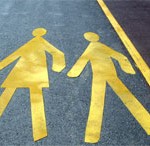Search Results
-
Give Me a Sign
I recently bicycled from Seattle to Bellevue, Washington, across Lake Washington on the I-90 floating bridge. This trip is not complicated. Once you’re on the wide, well-shielded bike lane, you’d think that getting to Bellevue would be assured. You’d be wrong. First, you have to get across Mercer Island. On the island, the bike route leaves the freeway and vanishes into a labyrinth of branching paths. They’re beautiful bikeways, no...Read more » -
My Backyard Carbon Sink
When my wife and I bought our house, the yard was typical for our neighborhood: a mostly barren plain of lawn so sunbaked that you could bounce a tennis ball off it. So being eco-groovy types, we’ve tried to improve the place: we put in a rain barrel, built a natural drainage system, and added topsoil planting berms. But I’m most proud of the trees we’ve planted: a pair of akebono...Read more » -
Gas Money
The US Northwest gets a raw deal when it comes to the economics of driving. We import from outside the region virtually every car we drive, not to mention nearly every gallon of fossil fuel we burn. So, the lion’s share of the money we spend on driving goes elsewhere. (Our newly updated energy counter illustrates this point with dramatic flair.) Interestingly, a new report from a Portland economist makes...Read more » -
A Mile in My Shoes
Sheesh. Wouldn’t you know it, the “walking is bad for the planet” meme has reared its head yet again, this time in a British newspaper: Food production is now so energy-intensive that more carbon is emitted providing a person with enough calories to walk…than a car would emit over the same distance. The climate could benefit if people avoided exercise, ate less and became couch potatoes. This made its way...Read more » -
What’s Walkable?
A collection of research and solutions–including walkscore.com–for creating walkable communities and why it’s important.Read more » -
Sticker Shocker
Everyone knows that cars are expensive, right? Still, it may come as a surprise to find out just how much money we spend getting from place to place. The cost of the car itself—typically the second biggest purchase many families make in their lives—is just the start. When you start adding in the cost of gasoline, and car insurance, and maintenance and repairs, and parking, and taxes to build new...Read more » -
Monday vs. Wednesday
During my daughters’ school year—back when my two-stop commute was particularly gnarly—I noticed what must be a familiar pattern to long-time Seattle-area I-5 commuters: traffic on Monday and Friday mornings tended to be way better than it was from Tuesday through Thursday. In my experience, it was pretty common for the entire highway to be clogged for miles—even the carpool lanes—on Tuesday, Wednesday, and Thursday. But on a good Monday...Read more » -
Cascadia Scorecard: Easing Off the Gas?
(Listen to the KUOW story on gasoline trends.) One of the most striking findings from this year’s Cascadia Scorecard (just released today, by the way) is that northwesterners are using less gasoline. In fact, per person gas consumption on the Northwest’s roads and highways has fallen by nearly a tenth since the late 1990s. To put the recent declines in context: cutting gas consumption by nearly a tenth is equivalent...Read more » -
More What "Bike Friendly" Looks Like
Separate bikeways are the lead actors in bike-friendly cities, but many supporting actors complete the cast: bikes on transit facilities, good traffic law enforcement, even bike “lifts” on steep hills. Three more worth mentioning are blue lanes, parking cages, and cyclibraries. 1. Blue lanes. My youngest son often bikes to drama rehearsals. It’s about three miles, mostly on traffic-calmed neighborhood streets and a bike trail—pretty good bikeways, overall. The only parts...Read more » -
Social Engineering Watch
Get this: not spending tax dollars to build a parking garage is “social engineering,” according to a column in today’s P-I. Go figure.Read more »


